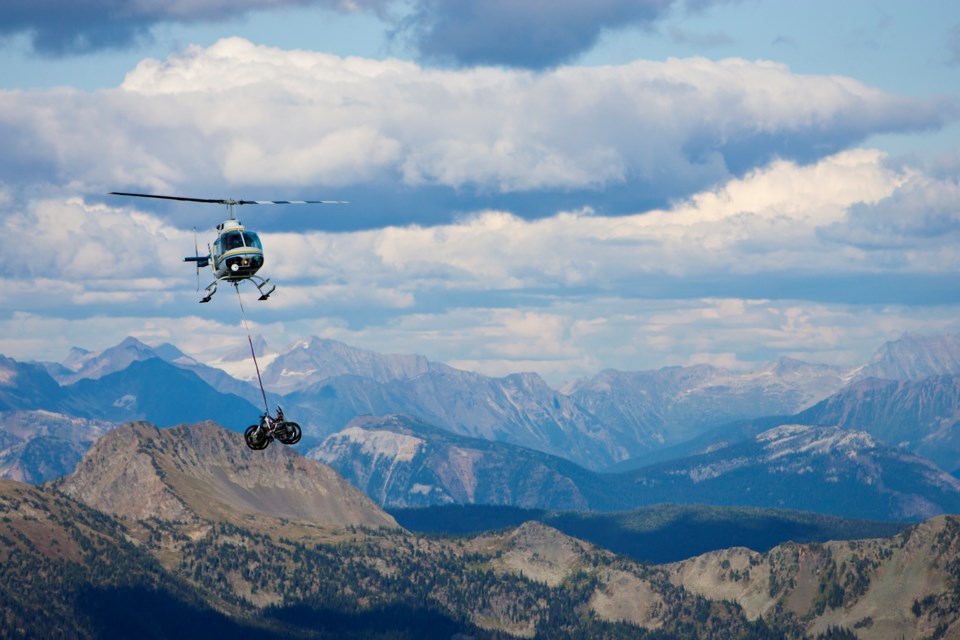Back in 1998, heli-biking wasn’t a thing—unless you lived in the Sea to Sky, in which case it was a maybe, kinda, sorta thing. With mountain biking just finding its feet outside of competition, all angles were being explored—nowhere more so than in B.C. And from my editorial desk at BIKE magazine in Southern California, I was always happily lured north to join in the pioneering, some of it rife with potential, some not so much—though it would all, in the end, contribute to the development of freeriding.
And so it was one August day that year, I found myself chipping in to sling bikes aloft from Britannia Beach below a helicopter stuffed with “Froriders” Richie Schley and Wade Simmons, North Shore MB mafia boss Johnny Smoke, and always-game photographer Eric Berger, bound for a legendary downhill known as “Disneyland.”
Under azure skies, we were deposited in the still-snow-spotted sub-alpine (those were the days) where my colleagues donned full-face helmets and a disturbing amount of body armour for a tire-width trail that appeared to have been burrowed through ground-hugging vegetation by no more than a lemming or two. After dropping less than a hundred vertical metres we convened on a bench among scrub conifers where the trail, the riding—and the mind—began to open up. Soon, speeding along a roller-coaster track with constant views to the spectacular glaciers of the Tantalus Range, we reached a small lake, the last of the snow, and the end of anything resembling horizontality.
Entering forest, we pitched downward on loamy ramps, spiralling through empty understory in a desperate connect-the-dots of droppable granodiorite. The pitch was relentless and, to the uninitiated (hello!), arguably insane: while I set the benchmark for face-first handlebar vaults, Berger concentrated on quality endos and stomach-clenching switchback high-sides. At one point the trail bucked out of a dry stream bed to side-hill along a vertical quartzite outcrop; I’d almost cleared the formation when my right pedal clipped a root and tipped me toward the rock, where, with diamond-like precision, protruding crystals promptly exposed bone along my entire forearm between glove and elbow pad.
Breathless from the constant adrenaline rush, we rolled gasping onto a slickrock porch that still hung an amazing 1,000 metres above a hazy Howe Sound. The view was stunning, the sunlit rock welcome respite from the dark enclave of the forest. It almost eclipsed the searing arm pain and pumped-out braking muscles. After a few minutes’ blotting up blood and bandaging, we shot down a cabin-sized rock and back into the trees.
Over the next hour, like an unrelenting Niagara Falls barrel nightmare, we were sucked again and again over steep haystack drops as I desperately tried to stall each freefall with nothing but hope. At one point, Jacob’s Ladder appeared—30 vertical metres of bermed, log-reinforced, metre-wide switchbacks set atop a ridge, like a zipper stretched over a codpiece. I high-sided on the first turn, Berger on the second. We watched in amazement as the others inched downward, balancing like gymnasts at each corner. At the bottom, where the trail mellowed toward another rock porch, a full croquet set materialized—hoops, wickets, balls and mallets planted among the pine needles. Bucksaw and shovel remnants represented other artifacts of a strange culture that had obviously gone before. Who, or what had created this madness?
Apparently, motocross masochists with a penchant for chainsaw play had cut the trails over a decade. “The first time I was shown this place I was working in Squamish,” said Smoke. “And it changed my whole concept of riding. I brought a couple North Shore riders here and they went nuts, incorporating things they saw into their own trails. This is where the idea of the ‘Big Stupid’ rockface on The Skull [trail] came from; Disneyland had a definite influence on North Shore trails.”
This revelation put two evolutionary mysteries into perspective: Disneyland’s mix of rabid downhilling and technical circus acts had helped spawn two separate schools of B.C. riding: the purely hedonistic heli-drop downhill, and the sado-masochistic North Shore stunt ride. Schley had previously done Disneyland both by helicopter and by riding up an old mine road to the base of the ridge, then hiking the rest—some 1,200 vertical metres—carrying and pushing his bike. He concluded the downhill approach had more merit.
“Disneyland is too steep to ride up, so you may as well fly,” Schley said at the time, presciently adding: “I believe the future of mountain biking will be more like skiing. Lots of it will take place on ski hills [indeed the Whistler Mountain Bike Park opened the following summer] and there will be a much bigger downhill component; so heli-biking could be a legit segment. If heli-skiing were affordable, way more people would do it; purity and soul won’t cut it in the new millennium—it’s the age of technology and thrill-seeking.”
What we lacked in tech we made up in thrills, as the skydive continued through fairyland timber and across a single-plank bridge to Andrews Rock, an imposing five-metre face whose nose fell at 70 degrees onto a dirt compression, while the main wall pitched out to 90 for a bike-length then slammed the rider into an absolutely flat granite outrun. Cleaning it required nerves of steel, concentration, strength, and the kind of stupidity that only came from a bike with more front and back travel than a slinky—uncommon at the time. But the pros all aced the drop, Simmons even throwing in a little slalom flare around a crack system.
We hit the valley floor seven hours after setting out. Beaten, bruised and bloodied, I’d nevertheless contemplated the best fifty bucks I’d spent all summer. If there was any method in the madness of this kind of heli-biking it was this: after a surrealistic freak-show like Disneyland, even the gnarliest “regular” downhill seemed buff, and I believed I deserved it.
Leslie Anthony is a Whistler-based author, editor, biologist and bon vivant who has never met a mountain he didn’t like.




